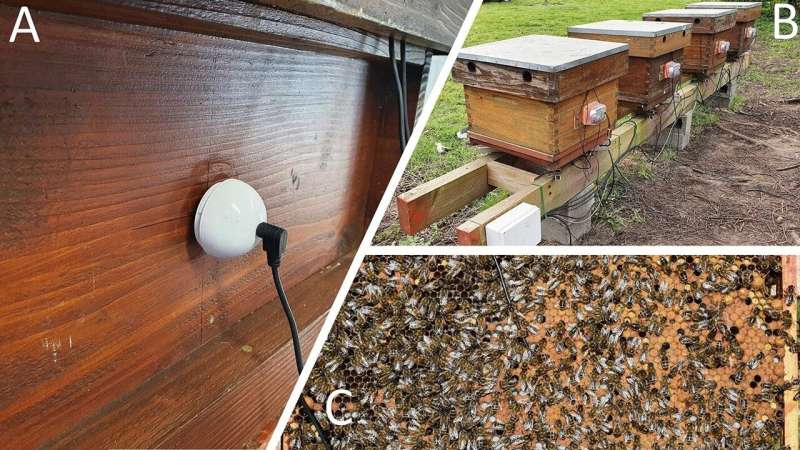This article has been reviewed according to Science X's editorial process and policies. Editors have highlighted the following attributes while ensuring the content's credibility:
fact-checked
trusted source
proofread
A gentle tap to the hive can reveal health of honeybee colonies, study confirms

Scientists at Nottingham Trent University investigated how thousands of bees reacted in unison to a very short and weak vibrational knock delivered at randomized times to a number of hives.
They found that by monitoring the insects' reaction to the technique, they were able to shed light on how active or restful they were inside the hive, without needing to look inside. The study, which also involved Ghent University in Belgium and Portugal's Coimbra University, is published in the journal Scientific Reports.
This is important as colonies should follow very specific patterns of activity over the year, where they should be very busy in the warmer months but very idle when it's cold.
During winter all foraging for food can stop for weeks or even months, and from outside it is not possible to tell if the colony is dead or alive.
Beekeepers can inspect hives by opening them, but this is an invasive process and can be detrimental to the colony.
Using their approach the team was able to detect and record bees' responses to the pulse throughout the year by using an accelerometer—sensitive to the insects' tiny vibrations—embedded within hives.
Monitoring colony activity through the signal produced by the bees flapping their wings, the researchers found from the data that sometimes they were very sensitive to the pulse, and other times not at all.
In the summer months, when bees were busy foraging for food, caring for their young and maintaining the hive, the researchers found that they paid little attention to the pulse.
Other than momentarily freezing as they observed the pulse, there was no change in signal as the insects continued to go about their business.
And as the weather got colder, following a very weak signal there was a strong group reaction by the bees after the pulse, returning to weak, indicating that the colony had clustered together for warmth and was indeed healthy.
Among the collective noise from the bees the technology also picks up the sound of individual bees making 'whooping' noises in surprise. The Nottingham team previously showed how bees made this sound when startled.
"It's a bit like a bear that falls asleep for the winter, sometimes you cannot tell if the animal is alive or not," said lead researcher Dr. Martin Bencsik, a scientist in Nottingham Trent University's School of Science and Technology.
"A gentle tap, causing a tiny, but measurable reaction, will reveal whether the animal is in its normal state or not."
The study—which involved analyzing thousands of hours' worth of data—found that in healthy colonies the response signal was nearly absent during the warmer active season, only appearing occasionally very early in the morning when the bees would be less busy.
The response signal then became very strong as winter arrived and then vanished again by late spring.
The health of one particular colony did deteriorate during the active season and it was the only one to exhibit a strong, long-lived buzzing response consistently throughout the summer while the colony kept slowly deteriorating.
The researchers argue that they have found a method to assess colony health from inside the hive without requiring a subjective perception of it.
They say that as far as they are aware it is the first investigation demonstrating something highly similar to an en masse 'reflex arc' taking place in an invertebrate. Usually undertaken on vertebrates, the reflex arc probes a particular neuronal pathway and involves an external stimulus which results in an involuntary response.
Dr. Bencsik said, "Some beekeepers knock on their hives with their hand, in the winter, to check and listen for a positive buzzing response to indicate the liveliness of the colony. Until now, however, the potential relevance of this simple test had never been looked into carefully.
"In the winter the bees should be very restful and in the summer they should be very mobile, unless they are unwell. Our pioneering method also allows us to test for mobility, revealing another aspect of the health and physiological status of the colony inside the hive.
"Our measurements reveal, non-invasively, colony mobility, the clustering of the colony and its restfulness, and can detect the absence of the queen in the active season.
"We believe our work might also help to give beekeepers an indication of the size of their colonies, based upon the strength of the signal."
It is hoped that the work could potentially lead to the development of a device to relay real-time information to beekeepers regarding their colonies so that they can be better managed.
More information: Martin Bencsik et al, Quantitative assessments of honeybee colony's response to an artificial vibrational pulse resulting in non-invasive measurements of colony's overall mobility and restfulness, Scientific Reports (2024). DOI: 10.1038/s41598-024-54107-8
Provided by Nottingham Trent University


















